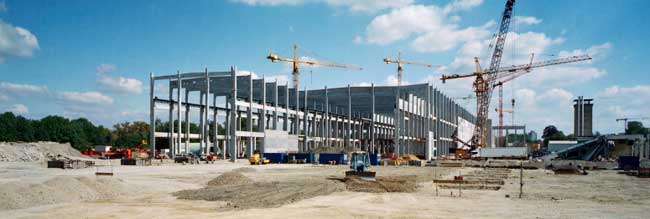The Environment of Successful Building Part II: The Installation
 If architects conceive structural integrity, construction contractors become the assemblers of installation success. The customer-builder relationship is influenced by numerous pressures: quality workmanship, building time and budget management.
If architects conceive structural integrity, construction contractors become the assemblers of installation success. The customer-builder relationship is influenced by numerous pressures: quality workmanship, building time and budget management.
The Clock
If time is money, it is especially so of installation success. When the clock starts, all stakeholders keep one eye on building time. Construction projects are often judged by timely delivery of installation success, and any backlog in construction produces client pressure.
 Clients and builders want quality workmanship on time, but the building business applies unrealistic pressure to building times. One can see it both ways. Any construction delay results in cost pressures. On the other hand, poor installation quality problems delay the project. That leads to a different kind of client pressure. When building time arrives, all stakeholders benefit from the awareness of time’s influence on construction objectives. However, many stakeholders do not understand the importance of moisture levels when scheduling construction projects.
Clients and builders want quality workmanship on time, but the building business applies unrealistic pressure to building times. One can see it both ways. Any construction delay results in cost pressures. On the other hand, poor installation quality problems delay the project. That leads to a different kind of client pressure. When building time arrives, all stakeholders benefit from the awareness of time’s influence on construction objectives. However, many stakeholders do not understand the importance of moisture levels when scheduling construction projects.
Quality Content
Installation success rests on the necessities of quality workmanship. Once poured, concrete needs to cure; once installed, wood needs to bond with its subfloor. Both materials contain moisture levels, and those moisture levels need to stabilize. No amount of client pressure changes that fact that installers must leave enough time for a quality installation. Moisture control is a central component of the building installation.
Moisture levels exert a surprisingly profound influence on installation success. Appropriate moisture levels are crucial to wood and concrete installation success. However, moisture levels are largely determined by the relative humidity (RH) surrounding those building materials. Wood and concrete moisture levels are influenced by changes in RH. Moisture content is not to be feared, but to be managed for installation success.
 If budget is paramount to installation success, clients who place building schedules before moisture levels could pay up to $35 per square foot of professional neglect. Building time blows the budget when concrete is too wet to proceed, or if wood adhesives break down. Talk about client pressure. Builders who succumb to impatience actually extend the overall project building time. Or, they have the unenviable task of informing the bosses that installations have failed. Impatience creates a nightmare scenario – for contractors, project managers, and clients.
If budget is paramount to installation success, clients who place building schedules before moisture levels could pay up to $35 per square foot of professional neglect. Building time blows the budget when concrete is too wet to proceed, or if wood adhesives break down. Talk about client pressure. Builders who succumb to impatience actually extend the overall project building time. Or, they have the unenviable task of informing the bosses that installations have failed. Impatience creates a nightmare scenario – for contractors, project managers, and clients.
The Read on Installation
Moisture level monitoring arms installers with the ability to ensure installation success by delivering quality on time. Zero client pressure. Builders install as directed, and they measure moisture levels with meters. Contractors can accurately monitor RH% in the concrete as the slab dries. This is critical in identifying when a finished floor product can be installed. Wood installers can run a hand-held moisture meter along the wood surface to instantly assess the many MC levels as a wood plank reaches equilibrium moisture content (EMC). That simple data empowers contractors to more precisely estimate building time. Pinless moisture meters enhance building installation success by non-invasively assessing moisture levels as they stabilize.
Who needs client pressure when you can turn building time into installation success? Good moisture levels let stakeholders sharpen their project completion mandates.
Additional Reading:
The Environment of Successful Building Part I: The Envelope
The Environment of Successful Building Part III: The Bond
The Environment of Successful Building Part IV: The Integrity